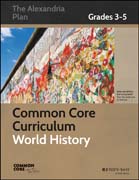
INDICE: Introduction: How to Use the Alexandria Plan Era 1 From First Fire to First Community: Humanity Evolves (ca. 200,000 BCE to 3000 BCE) Human Origins and Migration Paleolithic Societies and the Emergence of Human Culture The Agricultural Revolution Technology, Trade, and the Rise of Settled Communities Era 2 Civilizations Emerge: The Power of Words and of Bronze (ca. 3500 BCE to ca. 1000 BCE) The First Cities: Mesopotamia, Egypt, India, and China States of the Early Bronze Age The Invention and Impact of Writing The Later Bronze Age in West Asia and the Mediterranean Era 3 From Iron to Ideas: Religion and Freedom Take Shape (ca. 1700 BCE to 400 BCE) Bronze Age Collapse and the New Peoples of the Iron Age Ancient Israel and the Roots of Eurasian Monotheism The Revival of Greek Culture and the Expansion of Greek Influence The Brief Glories of Classical Athens Era 4 The Classical Era: Hellenistic Greece and Rome Flourish (400 BCE to 476 CE) Alexander’s Empire and the Hellenistic Legacy Rome Rises Imperial Rome and Its Breaking Point Christianity, Constantine, and the Decline of the Western Empire Era 5 Religion and War: Driving Change in Asian Empires (1750 BCE to ca. 1650 CE) India: From the Vedas to the Guptas—Buddhism, Hinduism, and the Wider World Imperial China Emerges China from Tang to Qing Lands beyond China: Japan, Korea, and Southeast Asia Era 6 The Rise of Islam: Religion Travels on a Road of Silk (ca. 610 CE to 1500s) Islam’s Origins and Rapid Conquests Political Division and Cultural Achievement Amid Chaos, Continued Expansion Later Islamic Empires Era 7 Europe after Rome Fell: The Middle Ages Descend (400s to 1350) Europe Rebuilds in the Wake of Rome’s Fall The Carolingian Empire and Its Successors The Feudal States of Western Europe European Commerce and Culture: The Medieval Revival Era 8 The Renaissance: Thought Reborn and Made Beautiful (ca. 1300 to 1648) The Changing World of Late Medieval Europe Classical Revival, the Expansion of Learning, and the Rise of the Renaissance Exploration and the Roots of European Expansion The Reformation and Its Consequences Era 9 Americas North and South: The “New” World (ca. 20,000 BCE to ca. 1500 CE) Early Human Settlement of the Americas The Native Peoples of North America The Native Peoples of Mesoamerica The Native Peoples of South America Era 10 Europe’s Global Expansion (1492 to ca. 1700) Spain Takes On the New World Other European Powers Enter the Americas The African Slave Trade Intensifies Europe Expands into Asia and Eastern Colonialism Begins Era 11 The Revolutionary Roots: The Modern West (ca. 1600 to 1800) Uneven Growth and Economic Modernization Freedom versus Power: England and France in the 17th Century New Ideas Emerge in a Rapidly Modernizing Europe America and France Enter the Age of Revolution Era 12 The Industrial Revolution: Nationalism Unites (1790s to 1880s) Napoleon’s Europe Industrialization, Technology, Science—and Turmoil Napoleon’s Wake: Rising Threats to Europe’s Old Regimes Nationalists, Conservatives, and the Unification of Italy and Germany Era 13 Modern Imperialism: A Race of Conquest and Supremacy (ca. 1790s to 1900) European Empires Face Decline in the Americas Britain Takes Over India as Europe Edges into Africa The West’s Heavy Hand in the Pacific Late–Century Climax: The Disintegration of China and the Scramble for Africa Era 14 National Rivalries: The Eruption of Global Conflict (1880s to 1918) Empires in Collision Europe’s Tinderbox Europe’s Tensions Erupt into World War A New World of Science, Technology, War, and Culture Era 15 Depression after Versailles: The Rise of Totalitarian Powers (1919 to 1930s) The Versailles Settlement and Its Discontents Totalitarians Rising The Global Depression and the Entrenchment of the Nazis Science Advances in a World of Growing Danger Era 16 Global Calamity: Appeasement Failed and Global Conflict Returned (mid–1930s to 1945) Fascist Aggression Intensifies As Appeasement Fails, Europe Slides toward War Hitler Sweeps across Europe Global Conflict and the Devastation of Total War Era 17 Post–War World: An Iron Curtain Divides the Globe (1945 to 1960s) The Emerging Cold War Deterrence and the Uneasy Balance of the Superpowers The End of the Colonial Empires and the Rise of New Nations: South Asia and the Pacific Africa and the Middle East Era 18 The Cold War Thaws: Uneasy Cooperation between Nations (1960s to Present) Global Conflict and Diplomacy: Détente, China, and the Middle East The Cold War Ends and European Communism Falls The Changing Post–Cold War World Recent Trends: Global Ties and Conflicts Who Is Common Core Acknowledgments Index
- ISBN: 978-1-118-83524-1
- Editorial: Jossey Bass
- Encuadernacion: Rústica
- Páginas: 336
- Fecha Publicación: 26/03/2014
- Nº Volúmenes: 1
- Idioma: Inglés
